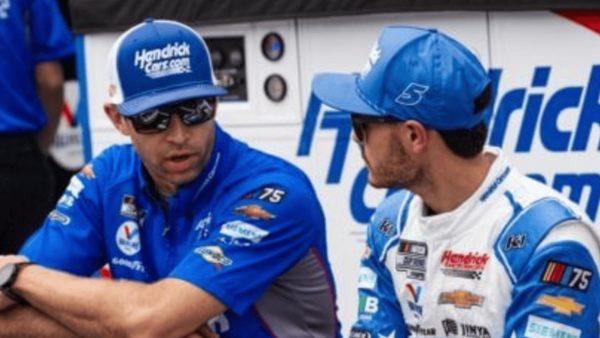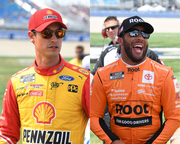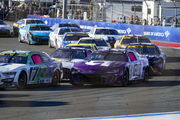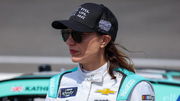

“Yeah, I mean, I agree. I probably have the worst average finish here of guys with more than three years of cup experience. So I’ll take being the underdog.” This is what Kyle Larson said when asked about being labeled an “underdog” at Talladega. The 2021 Cup Series Champion is one of the most versatile drivers in the world, conquering everything from dirt tracks to sprint cars and taking on the daunting Indy 500 last year. However, superspeedways have never been his bread and butter.
Despite dominating the 2025 NASCAR Cup Series with 170 stage points, his career record at Talladega and Daytona is a patchwork of pain. From flipping end-over-end at Daytona in 2023 to being swept up in wrecks, Larson’s “speedway trauma” has left scars. But Talladega 2025 was different. No massive pile-up. No race-altering crash. Yung Money crossed the line in third—his best-ever finish at a track like this. This clean top-three run was a hard-earned milestone, and his crew chief, Cliff Daniels, delved into the work they’ve put in behind the scenes.
ADVERTISEMENT
Article continues below this ad
Cliff Daniels dissects Larson’s run at Talladega
Let’s take a look at Larson’s Next-Gen results at superspeedways (Atlanta, Daytona, and Talladega) as a sample size of his recent outings. Since 2022, Larson’s highest finish at Daytona is a dismal 11th, with 4 finishes outside the top-20. As for Atlanta, Larson has 5 finishes of 30th or worse in the Next-Gen car. However, he finished 3rd in Atlanta this season, and overall, Talladega has probably been his only saving grace, notching up 4 top-25 finishes since 2022, including a 4th place at the fall race last year. Something seems to be changing in the #5 camp, and Cliff Daniels has seen the signs.
NASCAR Journalist Matt Weaver spoke to Daniels after the race and asked him, “Would you agree that a clean top-three at Talladega with Kyle [Larson] is pretty much all you could ask for at this stage of his superspeedway racing career?” Daniels was bold in his response. “I would push back in a friendly way on the narrative,” said Daniels.
Daniels then touched upon the nature of superspeedway racing and what the key difference was at Talladega that led to Larson’s impressive finish. He added, “I think we’ve seen a lot of signs of that over the years, you know, with connection-style speedway racing where, as we go through stage execution… Typically, the stage one and stage two, you know, completion isn’t very, you know, exciting or, you know, it’s not a lot of trouble that happens along the way. So those play out more straightforward, and today I think the difference with stage three played out really straightforward.”
Talladega is known for its big wrecks and last-lap crashes, like we saw in the Xfinity race on Saturday with Connor Zilisch. However, on Sunday, Stages 2 and 3 were run entirely under green flag conditions, making all the difference for the #5 team, according to Daniels.
Cliff Daniels says Kyle Larson is better at superspeedway racing than we or he gives himself credit for and that results don’t always show it
The 5 crew chief on strategy mattering and what conversations we need to be having about this car at tracks like this. pic.twitter.com/oyChfe1njb
— Matt Weaver (@MattWeaverRA) April 27, 2025
What’s your perspective on:
Is NASCAR losing its thrill with strategy over chaos at Talladega? What's your take?
Have an interesting take?
“A lot of the, you know, the plans and strategies that we’ve all kind of put into place. I thought it was good to see a couple different strategies in play today at times with some of the other OEMs, and that’s educational.” Daniels added, noting that it wasn’t just Chevrolet that thrived, as Ford won the race while Toyota and Chevy split the stages, showcasing the versatility on display at Talladega. The race also saw a staggering 65 lead changes among 23 different drivers, highlighting the sheer level of competition across teams and OEMs.
Early on, Toyotas like Chase Briscoe and Ty Gibbs dominated, forming single-file lines by lap 29, as seen in lap-by-lap data. By lap 134, six Toyotas held the top spots, showcasing disciplined strategy. HMS countered with their cohesion, with Larson winning Stage 1 on lap 60 and William Byron battling Austin Cindric for the lead on lap 177. But the final laps saw Ford’s Cindric and Ryan Preece steal the spotlight, dueling side-by-side on lap 186, with Cindric edging Preece by 0.022 seconds for a photo-finish win that briefly broke the race’s predictability.
Hendrick’s strategy—keeping their cars together to avoid trouble—worked like a charm. Young Money executed his role flawlessly. Chevrolet dominated the final standings, with five cars in the top 10. But the race’s predictability cast a strange shadow. Unlike the heart-pounding chaos fans expect from Talladega, this was a race of precision, not pandemonium. Larson and Byron were “mere pushers” at the finish. The absence of a “big one”, while safer, left the event feeling oddly hollow.
As Daniels dissected the race, his words unveiled an unsettling truth: NASCAR’s superspeedway spectacle, stripped of its chaos, risked becoming a mundane chess game that left fans wanting more, as a race where strategy reigns supreme can feel like a hollow victory for a sport built on unpredictability. Talladega 2025 was a masterclass in execution—and a stark reminder that NASCAR is not all about multi-car wrecks. For Larson, it’s a step forward after a week of steps in opposite directions.
Trending
Kyle Larson had a week of contrasting fortunes before Talladega
Kyle Larson’s heart soared as he clinched the Hy-Vee Perks 40 at Jacksonville Speedway on April 25, 2025. Starting sixth on a rain-soaked 1/4-mile track, he weaved past rivals, snatching the lead from Carson Macedo by lap 16. “For what Kyle Larson likes to do, yes, that was a lot of fun,” he said, grinning.
ADVERTISEMENT
Article continues below this ad
“I hope the fans enjoyed it. I know I did from my seat. Thank you guys for coming out. That was a good one.” The crowd roared, celebrating his sixth win in Jacksonville’s World of Outlaws history. Dirt racing is Young Money’s sanctuary, where he feels alive. This victory, despite cautions, proved his mastery, boosting his series lead. But joy turned to shock days later at the Indy 500 practice.
His Arrow McLaren car lost grip in Turn 2, crashing hard. “Honestly, though, I’m happy to crash my first IndyCar and live through it,” Larson said, shaken but unhurt. He blamed himself for not adjusting the weight jack, causing the understeer. The wreck sparked worry about his IndyCar readiness and grueling 2025 schedule—NASCAR, dirt, and now IndyCar.
Fans rallied behind him, knowing setbacks are part of racing. Larson’s eyes are now on Indy 500 qualifying. From Jacksonville’s dirt to Indy’s asphalt, His journey is a rollercoaster, but his heart stays steady, ready to chase the next checkered flag. His performance at Talladega only shows that as the years go by, Larson is learning, absorbing new information every time he takes to the tracks. It’s only a matter of time before we see him in victory lane at a superspeedway.
ADVERTISEMENT
Article continues below this ad
What do you think? Has Kyle Larson finally overcome his superspeedway hump? Let us know in the comments!
ADVERTISEMENT
ADVERTISEMENT
ADVERTISEMENT
ADVERTISEMENT







Is NASCAR losing its thrill with strategy over chaos at Talladega? What's your take?